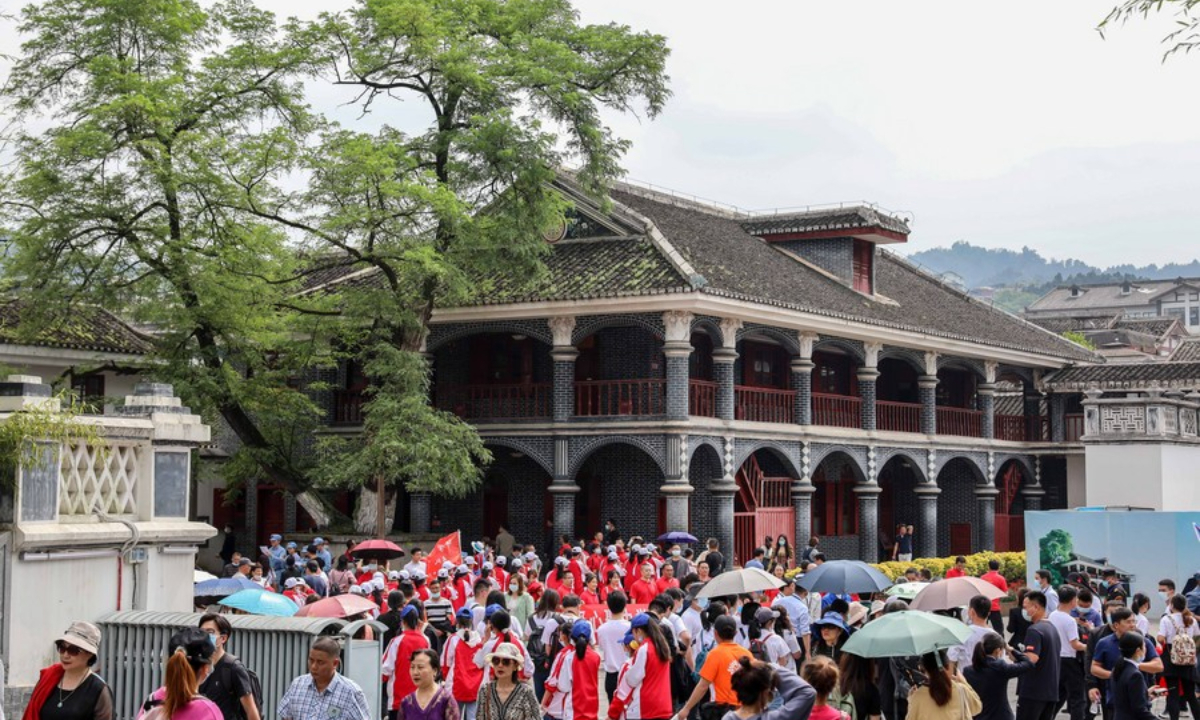
Tourists visit the site of the Zunyi Meeting, a watershed event in the history of the Communist Party of China (CPC), in Zunyi City of southwest China's Guizhou Province, May 20, 2021. Photo:Xinhua
In a move to provide a framework to conserve historical revolutionary sites across the country, China's National Cultural Heritage Administration has recently released guidelines that include a number of measures such as banning the "over commercialization and revamping" of such sites.
The new cultural guidance is titled "Guidelines for the Display of Revolutionary Sites (2023)." It contains a total of 19 measures, including specific requirements and scope of application.
It calls for the displays of such sites to remain in their "original" state to the greatest degree possible. The exhibiting space should reflect its original layout and style to accentuate a site's "sense of history." Original items should be prioritized as main exhibiting items. If they are damaged or are considered particularly precious or fragile, replicas can be used.
Using Jinggangshan Revolution Museum in East China's Jiangxi Province as an example, it hosts more than 7,000 historical artifacts, including a large number of original items. Museum expert Li Liyang told the Global Times that revolutionary sites are different to art installations and other modern cultural facilities as the experience of visitors hinges on a sense of history.
"Too much replacements on museum facilities, such as new furniture, will impact the immersive experience of tourists," Li said, noting that displaying original works sets an even higher standard for a site's security management.
Regarding public amenities at these sites, the guidelines noted that surrounding buildings should not stand out from a revolutionary site's "solemn historical ambience." The size of supporting facilities, including nearby restaurants and leisure hubs, needs to be strictly controlled. Grand plazas, large water facilities like fountains and swimming pools, and large green spaces should not be built in the name of constructing new memorial facilities.
Prior to these new regulations, in 2021, the main building of a revolutionary site in Mianyang, Southwest China's Sichuan Province was damaged by a local tourist enterprise, which started a project without official approval, according to Beijing Daily. The site was once the residences of Deng Jiaxian, Wang Ganchang and other China's "Two Bombs" pioneering scientists.
Cultural policy expert Song Weiping told the Global Times that the incident was a typical case of "inappropriate utilization of 'red' resources." Song said that red tourism is trending recently, making cities with well-known historical sites more popular. Yet, problems such as "unclear ownership" and "fragmented management systems" have in some cases led to indirect damage of important historical sites.
"This is the reason why we need targeted regulation with specific rules to guide this cultural tourist sector for its sustainable development," Song said.
Aside from rules made for revolutionary sites, the newly published guidance requires that guided tours of these sites should be "historical and facts based" and behaviors such as making fun of martyrs and revolutionary heroes are banned.
Two months prior to the issuance of the new guidance, the administration also released another notice to regulate guided tours for venues related to China's revolutionary history.
It specified that a stricter "supervising system" needs to be applied on such sites, noting that tour guides must not wear military uniforms or costumes that imitate military uniforms of any kind. Also, explaining materials for tour guides need to be examined and accredited prior to leading tour groups.
"Those venues have the major responsibilities for public patriotic education, especially for young visitors. We cannot afford to deal with the consequences of incorrect and misinterpreted Chinese history," Li stated.
Along with encouraging factual and history-based developments, the guidelines also noted the importance of using new technologies such as digital virtual tools for enhancing visitor experience.
"By adding new exhibition methods such as artificial intelligent tour guide and AR navigation systems, the influence, appeal and education of red history and culture have been effectively enhanced," said Yang Yanhua, deputy director of the memorial hall of Ruijin Central Revolutionary Base.
Red tourism, including historical cultural sites and revolutionary sites, has become very popular among young tourists. In the first half of 2023, 30 percent of visitors to red sites were people aged between 26 and 35. Historical cities such as Changsha in Central China's Hunan Province, Zunyi in Southwest China's Guizhou Province and Yan'an in Northwest China's Shaanxi Province were among the cities receiving the highest visitor numbers.
(责任编辑:百科)
